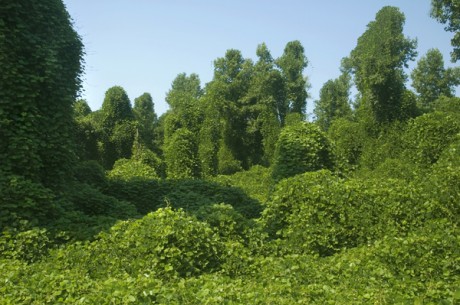Look out! Those invading plants don’t belong here!
How to know and grow your native landscape

How to know and grow your native landscape
If you've been to the mountains, you've probably seen kudzu vines literally smothering a forest edge. Or oriental bittersweet winding its way around trees inside the forest, literally choking them to death. Both are excellent examples of invasive, exotic plants — species that have been introduced to a region, either on purpose or accidentally, and have spread out of control. Because invasive plants are out of their original locale, the native control mechanisms (competing vegetation, insects, diseases, animals or weather patterns) are not in place. These plants can take over the landscape, pushing out the native plants that feed and shelter our native wildlife. They also disturb the beauty of the native landscape in our national parks and forests and other recreation areas and can be very difficult and costly to remove. Plant diversity is greatly reduced, sometimes to just a single invasive plant.
Invasive plants fall into every category, from trees to grasses. Purple blooms of the princess tree or paulownia can be seen throughout western North Carolina in April and May, creating thousands of tiny wind-spread seeds per pod which continue the spread of this invasive. Leaves of the winged burning bush turn scarlet in the fall, making invasive forest colonies easy to spot, although hard to remove. English ivy, periwinkles and big blue lilyturf or creeping liriope are all commonly used groundcovers which can spread out of control from even the most dedicated gardener. These are just a few of the many species which are permanently changing the face of our landscape.
One of the major problems with invasive plants is that they are often innocently used in our home landscapes and then wind, water, animal fur and droppings can carry seeds for miles to start a new, but unintended, colony of a plant. Many species also spread through root systems, no seed dispersal required. Numerous public agencies recommend that landowners should not plant invasives, and should remove and destroy those that may already be in the home landscape. It is recommended that one invasive not even be used as a decoration. Oriental bittersweet, which has beautiful fall berries and is often used to make wreaths, is wreaking havoc in western forests and costing taxpayer dollars to remove from places like Bent Creek Experimental Forest (part of Pisgah National Forest in Asheville).
Bring in the natives
Instead of using invasive plants, why not incorporate their native counterparts into your landscape? Native plants help provide wildlife habitat (which is decreasing due to development), promote biodiversity, are adapted to the climate, and are generally easier to maintain and require less water than invasives. Instead of the paulownia, consider the southern catalpa or the eastern redbud. The burning bush can be replaced by a native azalea or fothergilla. Native phlox, aster or ferns are excellent groundcover choices. You might also consider planting edibles such as apple or pawpaw trees, blueberry bushes or herbs for an aesthetically pleasing landscape and healthy, free produce.
Two great resources for determining which native plants are suited for your region are your local Cooperative Extension agent and the Going Native website: www.ncsu.edu/goingnative. The site is a cooperative effort between the N.C. Forest Service and N.C. Cooperative Extension Service and walks you through each step of designing your own native landscape, including suggesting native plants for your site conditions and where you can purchase them.
As you choose native plants for your landscape, remember to factor in your light and moisture availability, as well as soil pH. To protect native plant colonies, you should buy nursery-propagated plants instead of digging from the wild. And do your research on invasives before shopping. Ask at the nursery about each plant's invasive status. Many invasive plants are still commonly sold at local nurseries and home improvement stores.
You can be an ambassador for the environment just by encouraging friends and neighbors to do the same. One landowner at a time can make a collective difference by growing a native landscape!
-
Share this story:


